Andres Garcia-Saavedra
TelecomRAG: Taming Telecom Standards with Retrieval Augmented Generation and LLMs
Jun 11, 2024Abstract:Large Language Models (LLMs) have immense potential to transform the telecommunications industry. They could help professionals understand complex standards, generate code, and accelerate development. However, traditional LLMs struggle with the precision and source verification essential for telecom work. To address this, specialized LLM-based solutions tailored to telecommunication standards are needed. Retrieval-augmented generation (RAG) offers a way to create precise, fact-based answers. This paper proposes TelecomRAG, a framework for a Telecommunication Standards Assistant that provides accurate, detailed, and verifiable responses. Our implementation, using a knowledge base built from 3GPP Release 16 and Release 18 specification documents, demonstrates how this assistant surpasses generic LLMs, offering superior accuracy, technical depth, and verifiability, and thus significant value to the telecommunications field.
Fair Resource Allocation in Virtualized O-RAN Platforms
Feb 17, 2024Abstract:O-RAN systems and their deployment in virtualized general-purpose computing platforms (O-Cloud) constitute a paradigm shift expected to bring unprecedented performance gains. However, these architectures raise new implementation challenges and threaten to worsen the already-high energy consumption of mobile networks. This paper presents first a series of experiments which assess the O-Cloud's energy costs and their dependency on the servers' hardware, capacity and data traffic properties which, typically, change over time. Next, it proposes a compute policy for assigning the base station data loads to O-Cloud servers in an energy-efficient fashion; and a radio policy that determines at near-real-time the minimum transmission block size for each user so as to avoid unnecessary energy costs. The policies balance energy savings with performance, and ensure that both of them are dispersed fairly across the servers and users, respectively. To cater for the unknown and time-varying parameters affecting the policies, we develop a novel online learning framework with fairness guarantees that apply to the entire operation horizon of the system (long-term fairness). The policies are evaluated using trace-driven simulations and are fully implemented in an O-RAN compatible system where we measure the energy costs and throughput in realistic scenarios.
Risk-Aware Continuous Control with Neural Contextual Bandits
Dec 15, 2023Abstract:Recent advances in learning techniques have garnered attention for their applicability to a diverse range of real-world sequential decision-making problems. Yet, many practical applications have critical constraints for operation in real environments. Most learning solutions often neglect the risk of failing to meet these constraints, hindering their implementation in real-world contexts. In this paper, we propose a risk-aware decision-making framework for contextual bandit problems, accommodating constraints and continuous action spaces. Our approach employs an actor multi-critic architecture, with each critic characterizing the distribution of performance and constraint metrics. Our framework is designed to cater to various risk levels, effectively balancing constraint satisfaction against performance. To demonstrate the effectiveness of our approach, we first compare it against state-of-the-art baseline methods in a synthetic environment, highlighting the impact of intrinsic environmental noise across different risk configurations. Finally, we evaluate our framework in a real-world use case involving a 5G mobile network where only our approach consistently satisfies the system constraint (a signal processing reliability target) with a small performance toll (8.5% increase in power consumption).
Indoor Millimeter Wave Localization using Multiple Self-Supervised Tiny Neural Networks
Nov 30, 2023



Abstract:We consider the localization of a mobile millimeter-wave client in a large indoor environment using multilayer perceptron neural networks (NNs). Instead of training and deploying a single deep model, we proceed by choosing among multiple tiny NNs trained in a self-supervised manner. The main challenge then becomes to determine and switch to the best NN among the available ones, as an incorrect NN will fail to localize the client. In order to upkeep the localization accuracy, we propose two switching schemes: one based on a Kalman filter, and one based on the statistical distribution of the training data. We analyze the proposed schemes via simulations, showing that our approach outperforms both geometric localization schemes and the use of a single NN.
ARENA: A Data-driven Radio Access Networks Analysis of Football Events
Oct 19, 2020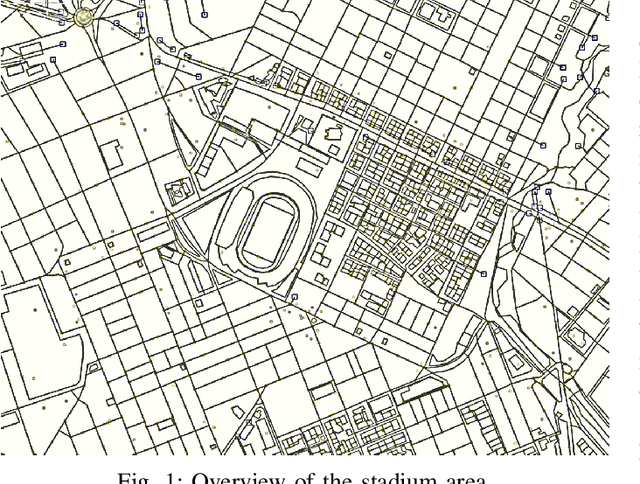
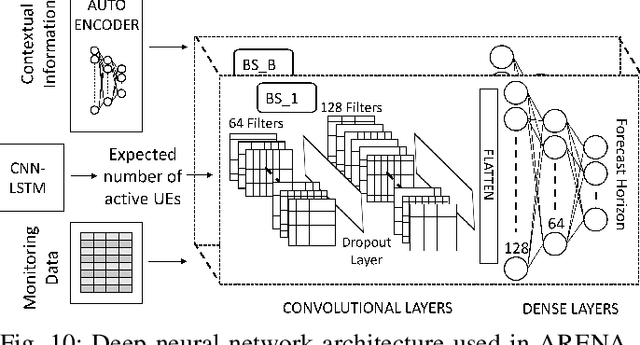
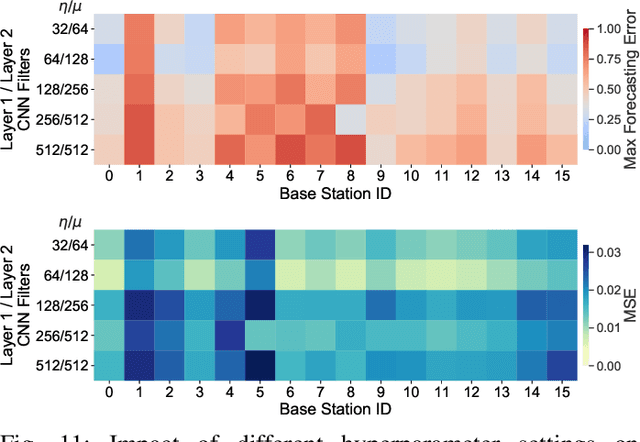
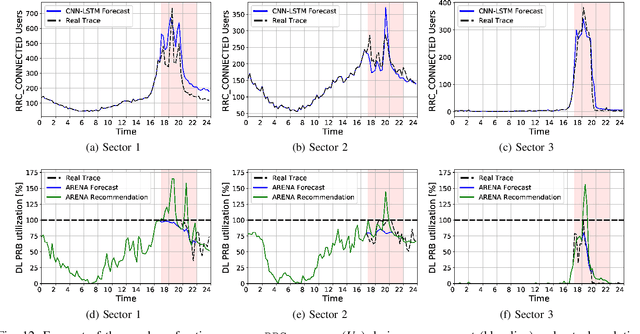
Abstract:Mass events represent one of the most challenging scenarios for mobile networks because, although their date and time are usually known in advance, the actual demand for resources is difficult to predict due to its dependency on many different factors. Based on data provided by a major European carrier during mass events in a football stadium comprising up to 30.000 people, 16 base station sectors and $1$Km$^2$ area, we performed a data-driven analysis of the radio access network infrastructure dynamics during such events. Given the insights obtained from the analysis, we developed ARENA, a model-free deep learning Radio Access Network (RAN) capacity forecasting solution that, taking as input past network monitoring data and events context information, provides guidance to mobile operators on the expected RAN capacity needed during a future event. Our results, validated against real events contained in the dataset, illustrate the effectiveness of our proposed solution.
LACO: A Latency-Driven Network Slicing Orchestration in Beyond-5G Networks
Sep 07, 2020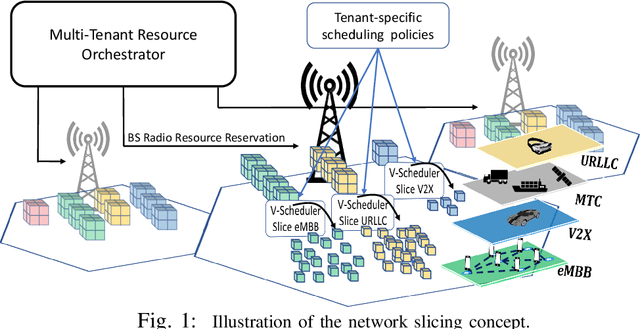
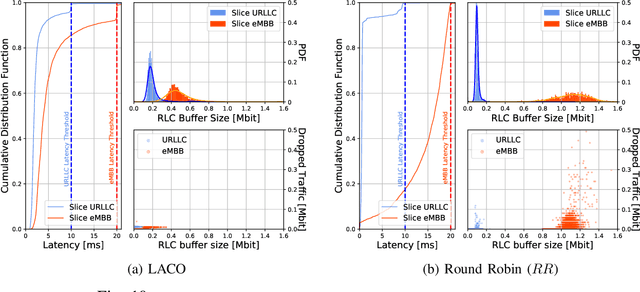
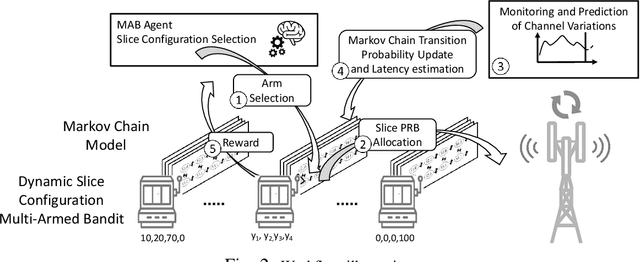
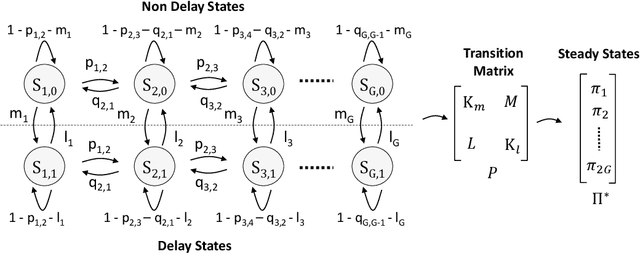
Abstract:Network Slicing is expected to become a game changer in the upcoming 5G networks and beyond, enlarging the telecom business ecosystem through still-unexplored vertical industry profits. This implies that heterogeneous service level agreements (SLAs) must be guaranteed per slice given the multitude of predefined requirements. In this paper, we pioneer a novel radio slicing orchestration solution that simultaneously provides-latency and throughput guarantees in a multi-tenancy environment. Leveraging on a solid mathematical framework, we exploit the exploration-vs-exploitation paradigm by means of a multi-armed-bandit-based(MAB) orchestrator, LACO, that makes adaptive resource slicing decisions with no prior knowledge on the traffic demand or channel quality statistics. As opposed to traditional MAB methods that are blind to the underlying system, LACO relies on system structure information to expedite decisions. After a preliminary simulations campaign empirically proving the validness of our solution, we provide a robust implementation of LACO using off-the-shelf equipment to fully emulate realistic network conditions:near-optimal results within affordable computational time are measured when LACO is in place.
 Add to Chrome
Add to Chrome Add to Firefox
Add to Firefox Add to Edge
Add to Edge